The origin of this exercise is perhaps as odd as the idea itself: while weeding my devastated Mad-Max-style front yard in preparation to lay sod this past summer, I was listening to the audio version of Stephen Mitchell’s lovely Gilgamesh: A New English Version. As I listened, I imagined the how the story would look if it were steampunked. Who would Gilgamesh be? What would Enkidu look like? What city would replace Uruk? I never seriously pondered writing it down, until I hit 800 followers on Twitter, and decided to celebrate the landmark with 80 tweets comprising an outline of a steampunked Gilgamesh. As part of Steampunk Week here at Tor, here is that outline with annotated explanations.
1. I’ll be using Stephen Mitchell’s excellent Gilgamesh text as source for the direct quotations in these tweets. I used Stephen Mitchell because he fills in the gaps in the text, making it far more readable than literal translations of a single version of Gilgamesh. If you’re going to read the Epic, this is the version to start with. If you’ve never read Gilgamesh, either take the time to read Mitchell’s version, or read an online summary – the steampunked version will make more sense.
2. Instead of walled Uruk, we behold a skyscraper in New York, early 20th century: “Doc” Gil Gamesh’s achievement. The Gilgamesh Epic (GE) as written by Sin-Leqqe-Unninni begins with a sort of frame narrative, asking the reader to behold the wonders of ancient architecture manifest in Uruk, the city Gilgamesh built. I chose New York over London because New York’s skyline exemplifies the pinnacle of industrial ingenuity better than London’s. Further, I was thinking of how Lester Dent describes New York in Land of Always Night, a Doc Savage adventure: “In the center of New York City, the skyscrapers jut up like silver pines, each seemingly striving to overshadow the other; but there is one building taller and finer than all the rest, an astounding mass of polished granite and stainless steel towering nearly a hundred stories into the sky, a structure that is possibly man’s proudest building triumph.”
3. Gil Gamesh (borrowed that from Philip Roth), is a Doc Savage-like figure, with a rampant libido and massive ego. The Doc Savage of the pulps has little interest in romance, choosing to maintain a platonic lifestyle, but embodies the ideal intellect and physical prowess of Gilgamesh. The Gil Gamesh reference is from Philip Roth’s The Great American Novel, where he is a baseball player.
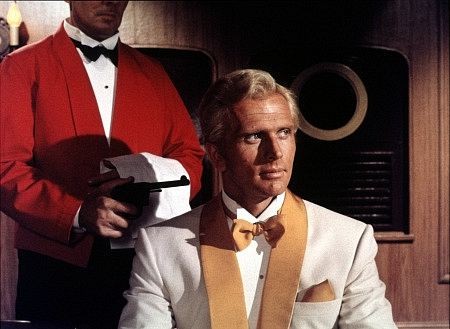
4. As a prize fighting pugilist and superb athlete, he “takes the son from his father and crushes him.” We’re not sure what this means, but some scholars speculate it had to do with contests of athletic ability, possibly wrestling. I went with the sport of the day in early 20th century America.
5. As a Doc Juan Savage, he “takes the girl from her mother and uses her.” Bastard. Again, it’s uncertain what is meant by this phrase, but we can reverse engineer that it’s a sexual free-for-all on Gilgamesh’s part from a later incident involving a sort of “first night” ritual with new brides.
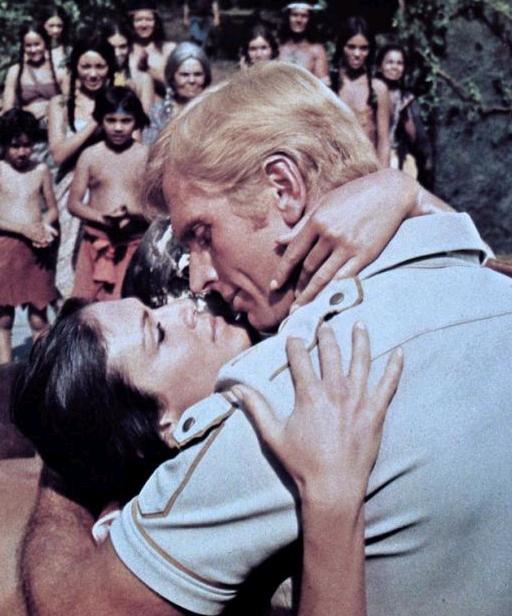
6. The people wonder what to do about Doc Gilgamesh (Doc G), and appeal to their leaders for help. They appeal to the gods in GE, but I wasn’t comfortable in introducing that level of fantasy – besides, the gods early 20th century America would cry out to would arguably be Christian, and unlikely to solve the problem of Gilgamesh by sending a hairy wild man to be his match. The whole idea of having Enkidu created on the spot had to go as a result.
7. The government asks Doc G to organize an expedition to an unexplored territory of Africa. Instead, I worked backwards from my decision to have Enkidu be a sort of Tarzan-like figure. If Doc G is to meet Enkidu, he will need to go to Africa. Within the context of this outline, it’s a decision to turn Doc G’s attentions to a major project that will channel his energies.
8. Doc G plans and funds the expedition to find ancient ruins in Africa, though this is a front for stealing resources. The resources are another reverse engineered moment, stemming from the battle with Huwawa, the Guardian of the Forest. There’s a sort of ancient eco-criticism in GE, where Gilgamesh wants to kill the Guardian and chop down trees (and skip and jump), but is warned off this by other leaders of Uruk. Gilgamesh is a grade-A jerk at the start of GE, so Doc G needed to be one too.
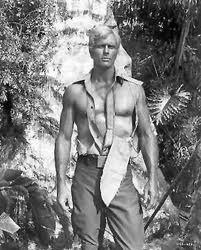
9. Trapper, one of the expedition’s scouts returns with tales of a wild man: Enkidu, rendered as Burrough’s Tarzan. Burrough’s Tarzanwith one major change: he’s not white. As will be revealed later, my steampunk Enkidu is a combination of Tarzanand boxer Jack Johnson. Were this to be fleshed out into an actual novel, it would present a number of really great moments to investigate racism in the early 20th century, and to turn the Greystoke legend on its head a bit, perhaps steampunk Kipling in the bargain.
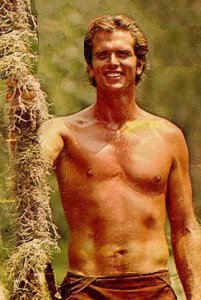
Not THIS SkinnyTarzan, although that would be an interesting play on Enkidu as Gilgamesh’s “double.” Rather, something more like Mr. Michael Clarke Duncan. We’re gonna need a bigger Gilgamesh….
10. Enkidu Tarzan will not allow the expedition to enter his domain – he is the Lord of the Jungle!
11. Doc Gilgamesh solves the problem by wiring the Moulin Rouge, and requesting Shamhat, a cross between Satine and Mata Hari. As Stephen Mitchell notes, we don’t have a word to translate what Shamhat is in the GE. Some scholars use “harlot,” but she’s more than just a prostitute: she’s a priestess of Ishtar. What’s the steampunk equivalent of a priestess of Ishtar? There really isn’t one, so I went with the courtesan, who was arguably more than just a prostitute. Besides, as Rivkah Harris has noted, it’s in Shamhat’s actions and words that her quality is revealed, not necessarily in her profession.

12. Doc Gilgamesh has concluded he can “civilize” this wild man by having Shamhat work her “love-arts” on him. Again, I think there is some potential for post-colonial critique in having the white Doc G assume he knows how to “tame” this wild black man.

13. Once the jungle denizens smell Shamhat on Enkidu/Tarzan, they will no longer serve him as they once did.
14. Shamhat agrees, and leaves the Moulin Rouge via airship, flying south to Africa.
15. Shamhat and Trapper enter the jungle, with the intent of seducing Enkidu/Tarzan. I should mention that in the GE, it is a trapper/hunter who accompanies Shamhat to seduce Enkidu, hence the name.
16. Shamhat successfully seduces Enkidu/Tarzan, and they make love for seven days. Now I’ve got the potential to sell this to a romance/erotica imprint!
17. Seriously. The original text says Enkidu could keep it up for seven days. Clearly, Viagra should have been called Enkidu.
18. And, on a side note, I couldn’t help but think of the terrible version of Tarzan starring Miles O’Keefe and Bo Derek when I wrote this. This is where the whole steampunked Gilgamesh idea started for me. I was listening to Stephen Mitchell’s ribald translation of the scene between Shamhat and Enkidu, and suddenly recalled Bo Derek saying “If the girls back home could see me now,” from the overplayed advertisement for the film on Superchannel back in the ’80s.
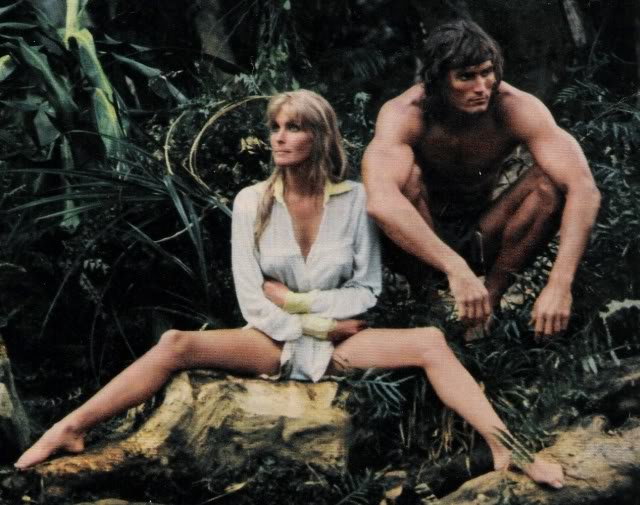
19. Shamhat suggests to Enkidu that he needs to meet “Doc” Gil Gamesh, and add his services as scout to the expedition. And by services, we want you to guide us to the interior of this strange new land. We want you to give us the keys to your culture, and then we’re going to ruin it, and put you on a reservation.
20. She describes New York, and how fantastic it is. Enkidu is intrigued, but would rather stay in Africa and make love.
21. At the expedition camp, Enkidu sees Trapper packing in anger: apparently, Doc G. has been bedding Trapper’s girlfriend back in NY. In the GE, Enkidu speaks to a man who is going to his wedding, who relates that Gilgamesh will have “first night” privilege with the new bride. This does not sit well with Enkidu. I went with straight up infidelity instead, which is ostensibly far more North American.
22. Enraged, Enkidu agrees to go to NY and kick Doc G’s ass. Doc G. sets it up as a prize fight. Add Jack Johnson to Enkidu’s aspect. I chose boxer Jack Johnson as a sort of intertext to the section on Johnson in Paul Guinan and Anina Bennett’s Boilerplate, which underscores the prejudice boxing fans had toward Johnson: “Back then, practically every white American male was a boxing fan. Unfortunately, a lot of them didn’t look kindly on the championship belt being worn by a black man.”
23. Via trans-Atlantic airship, Enkidu arrives in New York. Doc G. and Enkidu throw down in the ring. The earth shakes.
24. The fight is a draw: Enkidu is Doc G.’s match. Doc G. recognizes Enkidu as his “double, my second self.” One of the major themes of GE is close friendship and brotherhood. Enkidu is not Doc G’s sidekick – they are a dynamic duo, without any of the hierarchy of Batman and Robin. However, there is something lost in Enkidu’s acceptance of this new, “civilized” world, as we are about to see.
25. The expedition reports another obstacle: The Guardian of the Jungle, a powerful magical being. Or perhaps a sort of golem, since alchemy is so popular in steampunk tales. However it is explained, this is an otherworldly force that prevents the expedition from progressing.
26. The Guardian discerned Doc G’s intent to steal precious jungle resources, and destroyed the expedition’s machinery.
27. Doc G. decides to go and face the Guardian himself. Enkidu, reminded of his homeland, balks at the idea.
28. “A scream sticks in my throat…I knew that country when I roamed the [jungle] with the [elephant] and the [ape].” I’ve replaced the original GE animals with ones from Africa.
29. “The forest is endless. What man would dare to penetrate its depths?” Doc G. looks at Enkidu, and replies: “Me.” Here Enkidu seeks to dissuade his friend, who resorts to bravado and macho dares to goad his friend into coming with him.
30. World leaders tell Doc G. such a preemptive strike is a bad idea. “Leave the Guardian alone,” they advise.
31. But George Bush…I mean, *cough* Doc G. moves doggedly forward with his plans, calling Enkidu down for being a coward. Stephen Mitchell discusses the relevance of GE to the modern preemptive strike in his introduction to his version.
32. “If I die in the jungle on this great adventure, won’t you be ashamed when people say, ‘Doc. G met a hero’s death battling the Guardian!'” I can’t help but think of Lord Kraven, leader of Phileas Fogg’s League of Heroes in Xavier Maumejean’s novel of the same name, who is an unquestioning champion of Empire: “We are the Protectors of the Empire, my friend…The soldiers of good in the fight against evil. Surely, that is both moral and useful.”
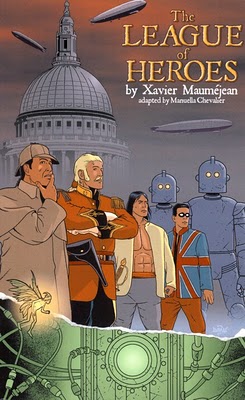
33. Enkidu’s pride is aroused. Both he and Doc G. order heavy weaponry from Dr. Grordbort’s Contrapulatronic Dingus Directory. Here’s the only directly metafictional reference I make, though were I to actually write this, it would contain many. Steampunking Gilgamesh would require a high degree of self-reflexivity and a good dose of ironic voice.
34. Doc G. orders “The Unnatural Selector,” “Lord Cockswain’s Weapon of Choice,” while Enkidu favors the Pomson 6000 sub atomic wave gun. Using Lord Cockswain’s Weapon of Choice puts Doc G in the company of Greg Broadmore’s hilarious lampoon of the Great White Hunter.
35. As everyone familiar with Grordbort’s rayguns will know, these weapons “can make the user more appealing to women…” This underscores the machismo we might associate with Gilgamesh as a younger man, before his journeys mature him into wisdom and humility.
36. And also “have some effect in stopping a man from crying himself to sleep at night, rocking gently like a useless baby.” Broadmore’s Victory and Dr. Grordbort’s Contrapulatronic Dingus Directory are great examples of how steampunk can be used to poke fun at current modes of male bravado through the lens of 19th century patriarchy, sexism, and ethnocentrism.
37. Doc G and Enkidu journey across the Atlantic, and into the African jungle, to do battle with the Guardian.
38. Enkidu questions Doc G one last time: “The Guardian is the forest’s protector. He is here for a reason. We shouldn’t do this.” I suppose someone might say I’m engaging in greenpunk now, but I try to avoid splitting my “_____ punks” too much.
39. Undeterred, Doc G. faces the Guardian. After all, he has a fortune to make on the backs of the third world. This is the perspective I hear being conflated with the “punk” in steampunk at conventions, that the colonial success of the 19th century, that Empire, is built on the backs of other nations or groups. The challenge of writing any fiction associated with this time period is to strike the balance between political commentary and engaging narrative. Again, I’d hold up Boilerplate as an exemplar of this.
40. When the Guardian sees Enkidu, he is enraged. “Child of the forest! We gave you shelter! This is how you repay us?” I love this moment, that the Guardian of the Forest chastises Enkidu for his effective betrayal. The polemic of good vs. evil is constantly problematized in GE. Aren’t we supposed to root for the hero? Yet we find it hard, when there’s really no larger purpose to his attack of the Guardian.
41. Doc G fries the Guardian with his Unnatural Selector. Countless readers mistake this for good striking down evil.
42. Enkidu becomes deathly ill on the return journey to New York. Doc G ascertains the source of the ailment, but keeps it secret. In the GE, Enkidu falls sick by the will of the gods, who have decided one of the heroes needs to die for the death of the Guardian. I’ve jumped past the Bull of Heaven episode here, as I couldn’t think of how to steampunk it…yet.
43. Doc G publishes a statement in the newspaper saying Enkidu was cursed by an African witch doctor. Gilgamesh has trouble reconciling himself to Enkidu’s demise from the moment he falls sick. He will deny the death until the corpse begins to rot.
44. In truth, Enkidu has contracted radiation sickness from the unshielded power source in the Pomson 6000 sub atomic wave gun. Enkidu’s death in the GE is ostensibly the result of his involvement with Gilgamesh’s unprovoked attack on the Guardian of the Forest: As with most of his rayguns, Broadmore warns that the Pomson 6000 sub atomic wave gun could produce “a tumourous growth caused by unshielded radiation,” providing me with a means to have Enkidu be the author of his own demise.
45. Enkidu curses Shamhat for convincing him to leave the jungles, calling her an old whore. This is one of the harshest moments in the GE, when Enkidu lashes out at Shamhat.
46. Shamhat reveals Enkidu’s radiation sickness, determining that his pride and needless violence are the source of this untimely death. And in line with Shamhat’s strength of character in the GE, she unflinchingly rebuts Enkidu, though with a different response.
47. Enkidu relents, apologizes, and makes peace with Shamhat. Shamhat, fed up with Doc G’s schemes, returns to Paris. I wanted Shamhat to have a “final word” of sorts. She’s such a strong character, and I imagine she’d be angry, yet ultimately unable to make any difference at this point.
48. Enkidu has a number of terrifying fever dreams about his death. Doc G calls up Carl Jung, who says something about archetypes and symbols. There are many dreams and interpretations in the GE. When Enkidu has dreams of death, Gilgamesh vainly explains them away as positive omens.
49. Accordingly, Doc G dismisses Enkidu’s dreams, refusing to accept that his friend is dying, and it’s likely his doing.
50. Even after Enkidu dies, Doc G refuses to face harsh reality, instead throwing himself into research into death. Since Gilgamesh persists in his refusal to accept Enkidu’s death, he reminded me of some portrayals of Victor Frankenstein.
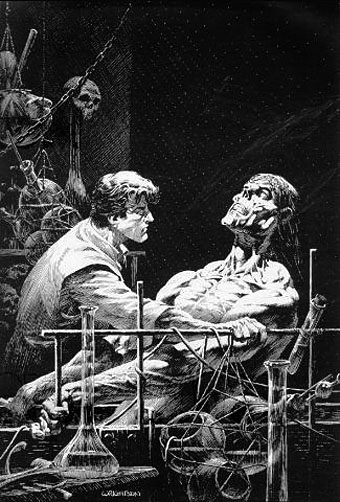
51. Using V. Frankenstein’s journals, Doc G attempts to resurrect Enkidu in his lab atop the Chrysler Building. What better place to get a lightning strike?
52. Building the spire to harness electricity, Doc G. has made New York a place which “no city on earth can equal.”
53. Yet he cannot bring Enkidu back to life: he witnesses a maggot crawl from Enkidu’s nose, and abandons the lab.
54. Doc G. leaves New York in his all-terrain steam vehicle, journeying across the world in search of immortality. I’m not totally satisfied with the all-terrain vehicle: in the GE, Gilgamesh undergoes a reversal of Enkidu’s journey: the civilized man wanders into the steppes, and becomes something of a wild man. However, I wanted to playfully fill the quest for immortality with Pynchonesque references to “Doc G’s collected adventures.”
55. His first adventure is close to home, in the town of Innsmouth, where he encounters the semi-immortal Deep One Hybrids. Gratuitous reference to H.P. Lovecraft’s “The Shadow over Innsmouth,” in which immortality comes at the price of becoming a twisted hybrid of human and fish/amphibian.
56. Horrified, Doc G battles the Deep One Hybrids: See Doc G volume 79, “Doc G. at the Bottom of the Sea” for details. All through Thomas Pynchon’s Against the Day,he keeps referencing the fictional adventures of his fictional steampunk boy-airship crew, The Chums of Chance: “see The Chums of Chance and the Evil Halfwit” or “The Chums of Chance Search For Atlantis.” I wanted to play with that approach as a way to include a host of immortality intertexts.
57. Next, Doc G. journeys to Transylvania to see if vampirism is the solution. See Doc G volume 80, “Doc G. vs. Dracula.”
58. The remaining series of Doc G books are largely concerned with this vain quest for immortality without consequence.
59. “Doc G. and the Flying Dutchman,” “Doc G. and the Struldbrugs,” “Doc. G and the Re-animator.” Yet another Lovecraft reference, along with Gulliver’s Travels.
60. As well as the source for the LXG film’s use of Dorian Gray, “Doc G. and the Cursed Painting.” More metafiction to explain why the movie included Dorian Gray.
61. In desperation, Doc G. visits Diamond Lil, at the Fountain of Youth National Archaeological Park in Florida. The Fountain of Youth National Archeological Park would be the last place one would likely go seeking the key to immortality, but I think I’d settled on a ludicrous approach after thinking like Pynchon for a few lines.
62. Dr. Luella Day McConnell , aka Diamond Lil, is saddened by Doc G.’s obsession and gives him the following advice. The words Luella Day McConnell presents Doc G with are word-for-word those of Shiduri, an ale-mistress Gilgamesh meets in his travels. Some scholars see this as the heart of the GE.
63. “Gilgamesh, where are you roaming? You will never find the eternal life that you seek.”
64. “When the gods created mankind, they also created death, and they held back eternal life for themselves alone.”
65. “Humans are born, they live, then they die. This is the order that the gods have decreed.”
66. “But until the end comes, enjoy your life, spend it in happiness, not despair… Savor your food, make each of your days a delight”
67. “…love the child who holds you by the hand and give your wife pleasure in your embrace. That is the best way for a man to live.”
68. But this is not enough for Doc G., and he leaves Diamond Lil, disappointed and nearly beaten in his quest. As it is for Gilgamesh in the GE. It’s good advice, but not to a man obsessed with immortality.
69. Disconsolate, Doc G. sets out again, only to be approached by a man named Rufus, who tells Doc G. of the City of Immortals. Here I was, only 10 tweets from needing to finish, and I still had all of Utnapishtim’s account of the flood and his ark. Instead of trying to steampunk that story, I tried to use the heart of Utnapishtim’s words of wisdom to Gilgamesh. In doing so, I found myself thinking of Jorge Luis Borge’s works on immortality. Tying these together, I referenced Borges’ short story, “The Immortal,” which is where I get the name for the steampunk Utnapishtim, Rufus, and the idea for the City of Immortals.
70. Rufus reveals that it was in Africa, and that Doc G.’s mining and clearcutting have effectively destroyed it.
71. “However,” Rufus says wryly, as Doc G. weeps, “you have found what you sought. You are already immortal.”
72. Doc G. is perplexed. “Let not the marble say what men do not,” Rufus says. “The essentials of a dead man’s life…will abide forever.”
73. “The trembling hope, the implacable miracle of pain, the wonder of sensual delight…all these will go on.”
74. “Blindly the uncertain soul asks to continue, when it is the lives of others that will make that happen.”
75. “You yourself are the mirror and image of those that did not live as long as you.” To which, Doc G. whispers, “Enkidu.”
76. “Yes,” said Rufus. “But others will be (and are) your immortality on earth. What monuments have you left, Gilgamesh?” All of Rufus’ speech is taken from Borges’ poem, “Inscription on Any Tomb,” translated by W.S. Merwin.
77. And so Doc G. returned to New York, liquidating his assets and selling his properties, after which he effectively disappeared. In the GE, Gilgamesh returns as a wiser king. He has become the shepherd of his people, as the introduction asserted he was. To that end, I thought I’d go with the route of Captain Nemo, who lives a life of secluded philanthropy after his disappearance in the maelstrom of 20,000 Leagues Under the Sea.
78. Yet another story is told, of a man who arrived in Africa shortly after Doc. G’s mining and clearcutting ventures pulled out.
79. No name survives, no records can prove his historical existence, and yet stories are told.
80. Stories of medicine, and education. But that, as I have already said, is another story. It’s interesting to me how steampunk imagines technological innovations of the fantastic, but often forgets the real-world innovations that were far more fantastic, related to the advances in medicine in the nineteenth and early twentieth century. Airships are cool, but I wouldn’t trade penicillin for them any day of the week. Those are the monuments worth leaving, and so is Doc G’s fictional legacy, once again referencing Doc Savage, who was a brilliant chemist.
Mike Perschon is a hypercreative scholar, musician, writer, and artist, a doctoral student at the University of Alberta, and on the English faculty at Grant MacEwan University.









